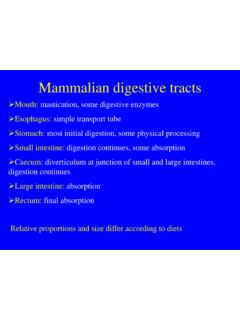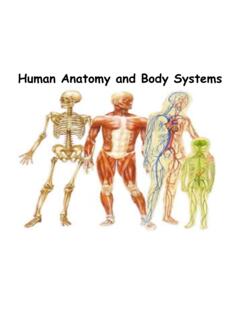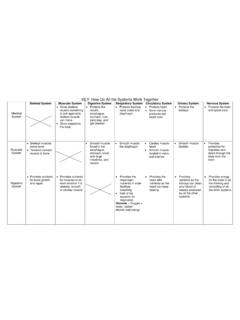Transcription of Your Body's Systems - Open School
1 Your Body's SystemsLiteracy Foundations Science: BiologyVersion 01 2012 by Open School BCThis work is licensed under the Creative Commons Attribution-NonCommercial International License. To view a copy of this license, visit Permissions beyond the scope of this license are identified in the materials by a copyright symbol and are outlined below. To request permission to use the exclusions to this Creative Commons license, contact the author/publisher of the third party materials:Third party copyright exclusions include:The human body Systems , Hemera, Used under license from (page 5, 41)SEM blood cells, National Cancer Institute, Bruce Wetzel (photographer).
2 Harry Schaefer (photographer). Image is in the public domain. (plasma, page 12)Bellows (PSF) line drawing, Pearson Scott Foresman, image donated to the Wikimedia Foundation and released into the public domain. (page 33) Project Manager: Jennifer RiddelProduction Technician: Caitlin FlandersCourse History New, June 2012 LITERACY FOUNDATIONS eTEXT SCIENCE: BIOLOGY | 1 OPEN School BCTable of ContentsLearning Package Overview ..3 Your Body's Systems ..5 Lesson A: Levels of Organization in Organisms ..7 Lesson B: The Circulatory system ..11 Lesson C: The digestive system ..21 Lesson D: The Excretory system Taking Care of Wastes.
3 29 Lesson E: The Respiratory system ..33 Lesson F: Relationships and Interactions of the Systems ..41 Appendix ..45 Activity Solutions ..46 Glossary ..51 Viewing Your PDF Learning PackageThis PDF learning package is designed to be viewed in Acrobat. If you are using the optional media resources, you should be able to link directly to the resource from the pdf viewed in Acrobat Reader. The links may not work as expected with other pdf viewers. Download Adobe Acrobat Reader: FOUNDATIONS eTEXT SCIENCE: BIOLOGY | 3 OPEN School BCLearning Package OverviewThis learning package is made up of several have a combination of reading and hands-on activities to give you a chance to process the material while being an active learner.
4 Each lesson contains several topics, self-marked activities, and some lessons contain links to online multimedia the end of the learning package you will find:SolutionsThis contains all of the solutions to the is a list of key terms and their definitions. Throughout the learning package, you will see the following icons:Check your answers using the Solutions at the end of the online to view a multimedia and ResourcesThere is no textbook required for this will be expected to have certain tools and materials at your disposal while working on the activities. These materials are listed in the activity and should be easy to find around the house or nearby.
5 In some lessons you will be directed to an online multimedia resource. Internet access is Science Orientation Skills (SOS) package is an online student resource for the basic science skills. Throughout this learning package, you will be directed to the SOS Package to read and review information that is central to the practice and study of science. The SOS Package can be found at: | LITERACY FOUNDATIONS eTEXT SCIENCE: BIOLOGY OPEN School BCLITERACY FOUNDATIONS eTEXT SCIENCE: BIOLOGY | 5 OPEN School BCYour Body's SystemsIn this learning package, you ll apply what you know about cell biology to learn about tissue development, and organ Systems .
6 You ll learn about four of the major body Systems : the circulatory system the respiratory system the digestive system the excretory systemWhile you ll be learning about each system separately, it s important to remember that each system connects and works with the other Systems to keep your whole body functioning. In this learning package. you will learn about: the relationship among cells, tissues, organs, and organ Systems the parts and functions of the circulatory system the parts and functions of the digestive system the parts and functions of the excretory system the parts and functions of the respiratory system how the body s Systems work together6 | LITERACY FOUNDATIONS eTEXT SCIENCE: BIOLOGY OPEN School BCLITERACY FOUNDATIONS eTEXT SCIENCE: BIOLOGY ETEXT | 7 YOUR Body's Systems LESSON A.
7 LEVELS OF ORGANIzATION IN ORGANISMS OPEN School BCLesson ALevels of Organization in OrganismsIntroductionSystems are made up of individual parts that work together and are usually connected to one or more other Systems . If one part of the system is damaged, the system will not function well or may not function at all. These characteristics are true of Systems in the human body. The human body is a complex system of interdependent parts that work together understanding how these parts work help us to understand the whole OrganizationIn a multicellular organism, such as humans, cells are specialized and organized to work together.
8 Groups of similar cells that have a common function form a tissue. Tissue cells are often stuck together with fibres or other sticky material. Groups of tissues having a common function are organized into organs. Many organs are made up of several different types of tissues. Some examples of organs in your body include the heart, lungs, kidney, liver, skin, eye, brain, and ears. Some examples of organs in plants are the roots, stems leaves, stamens, and ovaries. Groups of organs having a common function form an organ system . The human body is made up of many Systems including the: circulatory system digestive system excretory system respiratory system immune system skeletal system nervous system8 | LITERACY FOUNDATIONS eTEXT SCIENCE: BIOLOGYYOUR Body's Systems LESSON A: LEVELS OF ORGANIzATION IN ORGANISMS OPEN School BCTissuesThere are four types of tissues in the human body: muscle tissue nerve tissue connective tissue epithelial tissueMuscle tissue is responsible for movement in the body.
9 Think of all the different ways you can move your body: walking, lifting, writing all involve muscle tissue. Muscle tissue also allows your body to move in ways you can t often see. For example, did you know that your heart contains muscle tissue? The muscle tissue in your heart allows it to contract so it can pump blood to your whole tissue transmits messages through the body. It is crucial for our safety because it tells us how to respond to various changes inside and outside the body. For example, when you touch something hot, nerve tissues are what detect the heat and send a warning message to your brain.
10 Connective tissue holds other tissues together, and protects and insulates organs. This tissue is fibrous and helps give organs their tissue covers our body and the surface of various internal organs. This tissue provides a barrier between the organ it is covering and the environment around the organ. Its functions can include protection, absorption, and and Organ SystemsYour body is an amazing machine! Tissues are organized into organs and organs are organized into organ Systems . Get ready in the upcoming lessons in this learning package you will learn about four of the major body Systems : the circulatory system the respiratory system the digestive system the excretory systemLITERACY FOUNDATIONS eTEXT SCIENCE: BIOLOGY ETEXT | 9 YOUR Body's Systems LESSON A: LEVELS OF ORGANIzATION IN ORGANISMS OPEN School BCActivity 1 OrganizationComplete the flow cellsconnectivetissuebonesskeletalsystem Example:organismorgansystemorgantissuece llCheck your answers using the Solutions at the end of this learning this lesson has helped you to.










